Madrid Christmas Market
Arriving from a month of travelling in Cuba, I planned to share a Spanish year-end at the Puerta del Sol with the thousands of others who come to make the New Year welcome in peculiarly Spanish style – but first I had to explore the Madrid Christmas Market in the Plaza Mayor.
Madrid: Choose a gateway and you will be entranced from the moment of entry. Edificio Metrópolis, on the corner of Gran Via and Calle de Alcalá is one such – not really a gateway, but so grand it should be.
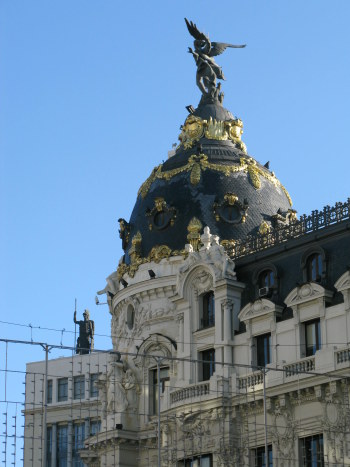
The already exotically decorated architecture of the city is so detailed that it soaks up descriptive adjectives.
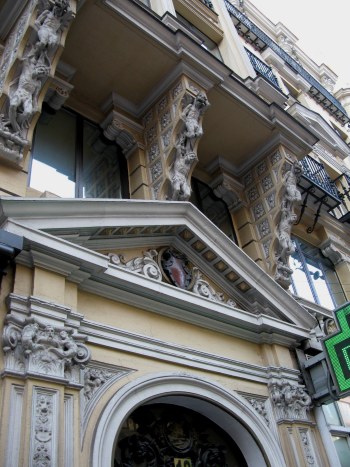
Madrid is a place of particularly Spanish decoration and a fitting capital to a country where embellishment is an art form.
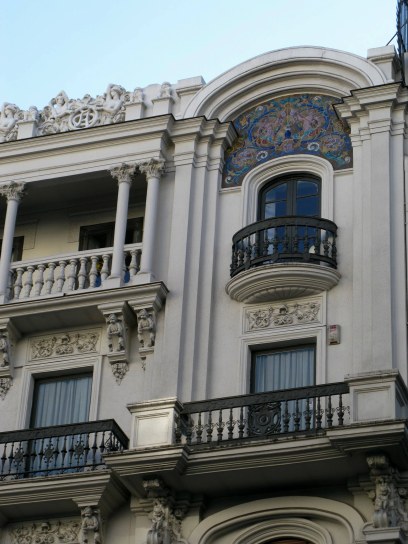
Colour and sculptured facades make Madrid a city whose architecture echoes its grand design of the past to be a force of dominion that left its imprint upon the wider world.
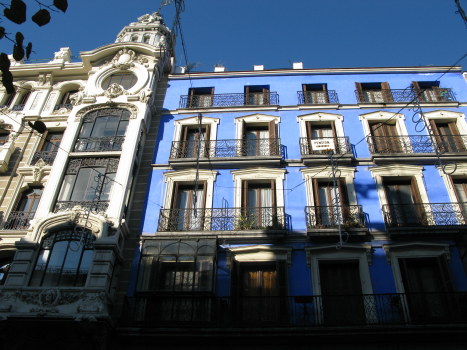
As you enter Madrid it is as if the whole place is like a piece if sculptural fantasy laid out like a Christmas Market just awaiting the season.
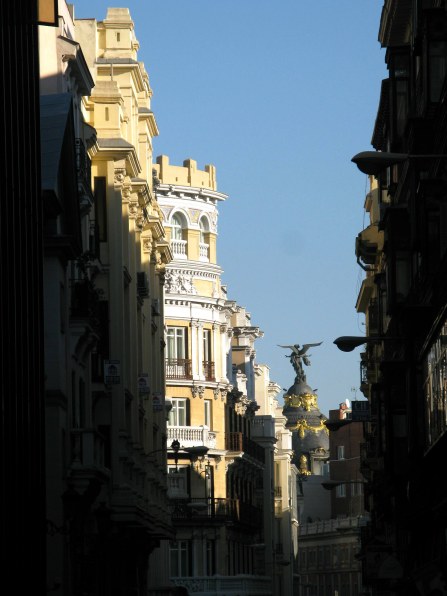
At Christmas this lavishness of design is further enhanced by lighting designed by top designers and artists, so that what was already exotic becomes in season a sort of lavish excess of light and form.
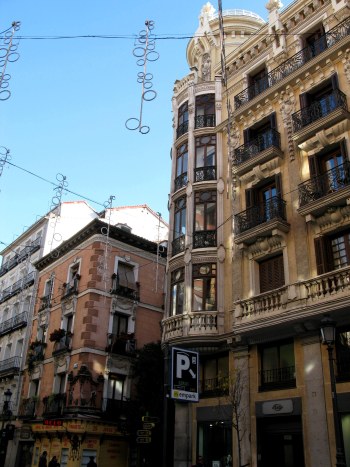
The festivals of Christmas and New Year are widely celebrated throughout the world, and yet we each have our unique ways of celebrating.
Ann Frank memorably said:
We all live with the objective of being happy.
Our lives are different and yet the same.
The Madrid Christmas Market demonstrates just how the different nuances of the festivities play out in different countries: different and yet the same.
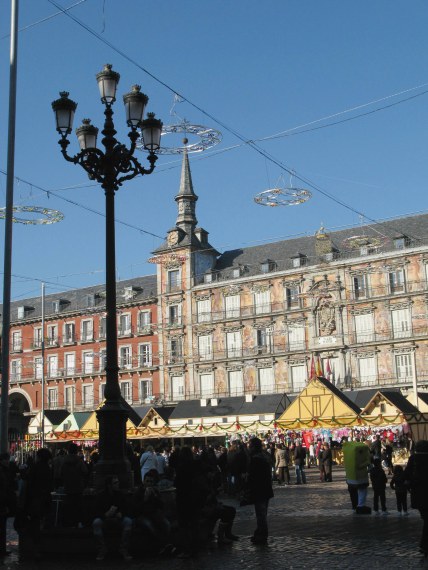
For the main Madrid Christmas Market over 100 log cabin-styled stalls fill the Plaza Mayor.
This magnificent plaza was built in 1860 but what we now enjoy was reconstructed in 1790 after a series of fires.
The oldest building within the plaza is the Casa de la Panadería, built in 1590, and once the premiere bakery of Madrid.
Over the decades the beautifully decorated frescoes on the facade have undergone several 'resorations'. That of 1914 apparently deteriorated the facade severely. In 1988 the Madrid City Council invited famous artists to compete to decorate tit anew. Carlos Franco won the commission, and it is his work that we now enjoy. The new designs included mythological figures including Proserpine, Bacchus, and Cupid – as well as some of his own creation that represented aspects of the history of Madrid of the Plaza Mayor itself. The work itself was undertaken in 1992.
Good things take time to season.
They say in Spain:
Tomorrow is the busiest day of the week.
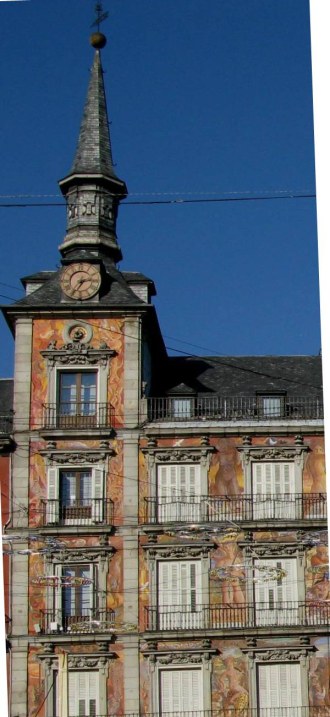
The flat-pack cabin look-alikes of the Christmas Market stalls makes a marked contrast to the lush mythical and historical characters on the facade behind them.
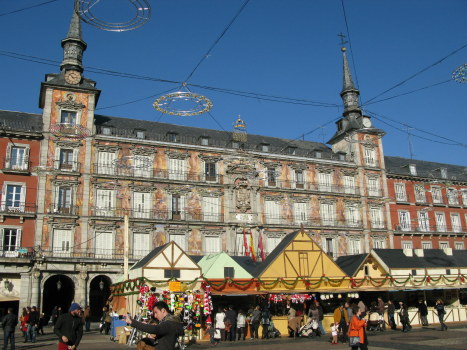
The timeless and the festivities of the moment sit comfortably side by side in the Plaza Mayor at Christmas.
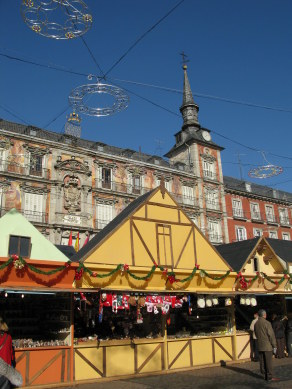
Here, are sold nativity figurines and carefully crafted terracotta-ware for creating a particularly Spanish manger scene. The resulting manger scene would be one instantly recognisable as Spanish, even with the freeze-dried leaves to make the palm trees.
I thought the storks a nice addition and one uniquely Spanish.
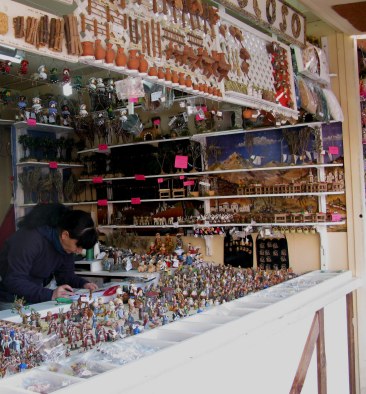
There are other stalls with Christmas stockings and novelties – lots of Christmas lights (it is Spain after all) on stalls sometimes overflowing.
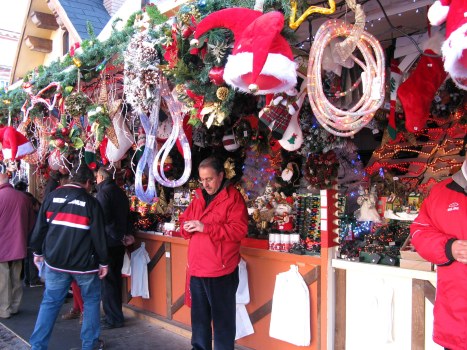
Apparently Santa needs really big Christmas stockings in order to accommodate the toys of the children of Madrid – for there seemed to be one size on display: extra large.
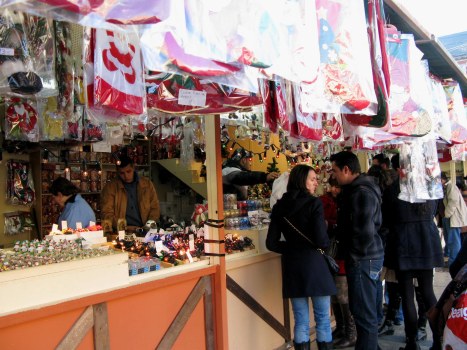
The Spanish Nativity scene – el Belén – is often a scene of the whole city with the three wise men arriving on camels, sometimes there is a woman spinning, a washerwoman at the river – and this all requires a fair bit of set dressing!
Unique to Spain is the addition of a peasant off in a corner somewhere having a poo.I never could understand the humour of that, although my Spanish friends thought it hilarious.
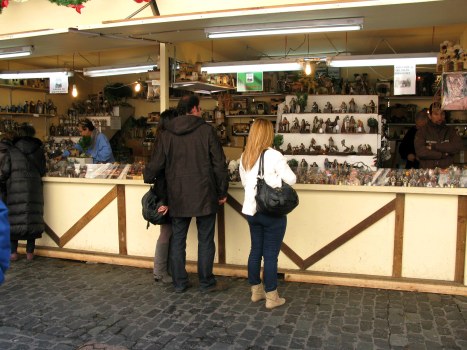
For outdoor nativity scenes all the trappings are there as well, from moss to the straw for the animals.
In a city it is always particularly important to find pine greens to decorate for Christmas, and this was definitely the place to come to choose them to flood you home with the fragrance of pine needles and spruce – the universal smells of Christmas.
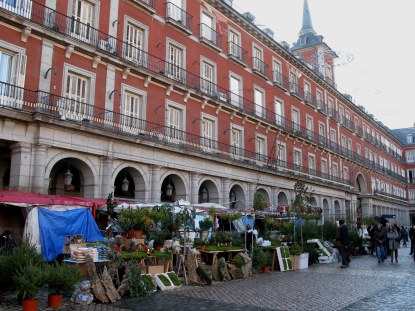
The greenery was much depleted by the time I got there, but the setting of the stalls against the arched colonnades with their beautiful lanterns was magnificent. I thought it must add unique charm to everyone’s experience of the Madrid Christmas Market.
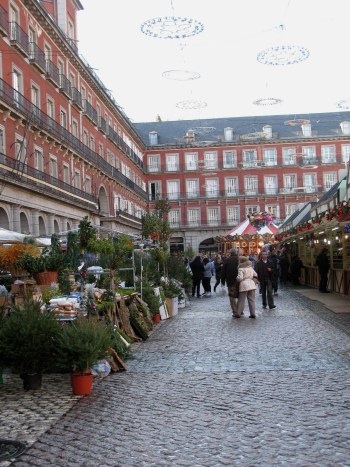
Over the centuries so many people of different cultures would have come here with the same expectations for the festive season, smiling as they watched the children’s wonderment and inhaling the pine fragrances.
For each it would be an experience different, yet the same.
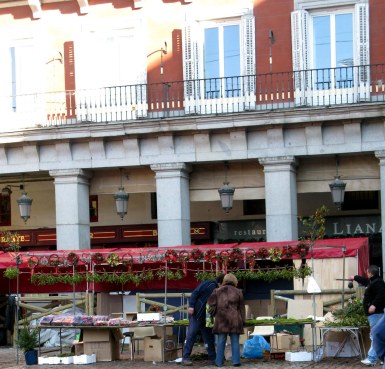
Of course Christmas Markets everywhere are places for friends to meet and share in the experience, and in the particular curiosities of each Christmas Market as the years pass.
I don’t know if the caricature artists are regulars each year, but they had their own corner of the Madrid Christmas Market on the Plaza Mayor.
I smiled to see that they were right beside the police wagon.
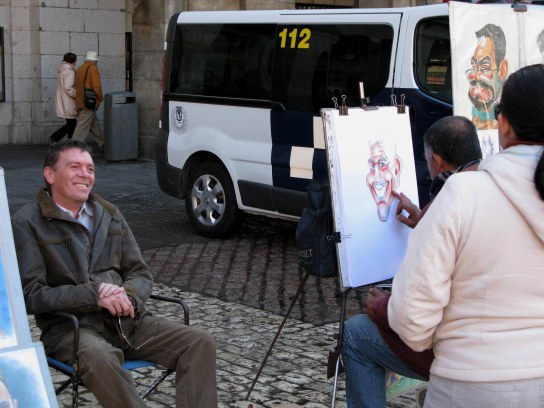
According to Walt Disney, who ought to know:
All cartoon characters and fables
must be exaggeration, caricatures.
It is the very nature of fantasy and fable.
This artist certainly had the larger than life principle down – but capturing character in the process has to be the real challenge of caricature.
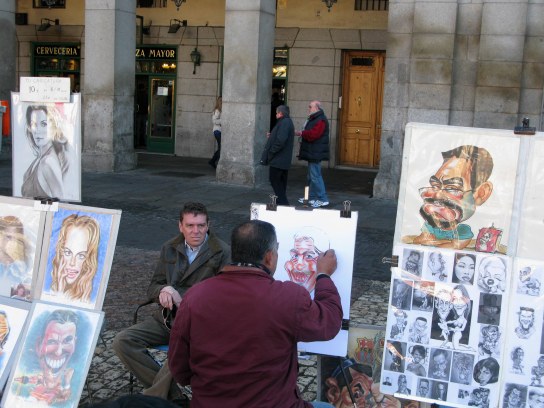
At the edge of the market, other artists displayed the sorts of Spanish scenes that they seem to think tourists seek out. For most locals, and for many other tourists too, another scene of a bullfight or a flamenco dancer is one too many.
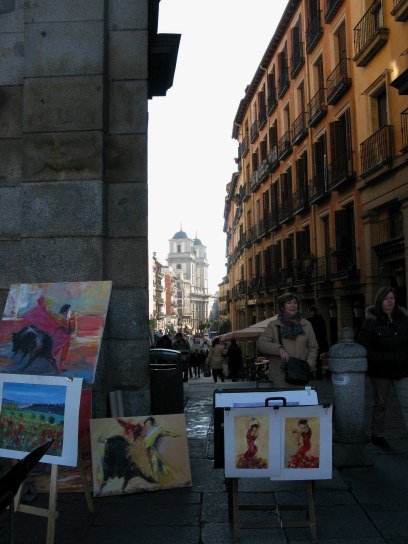
What doesn’t differ is the delight of children, whether it be the Madrid Christmas Market, or that of any other place.
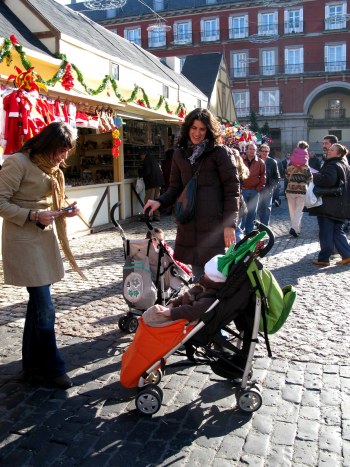
In the far corner of the Plaza Mayor from where I was standing, there was a colourful carousel.
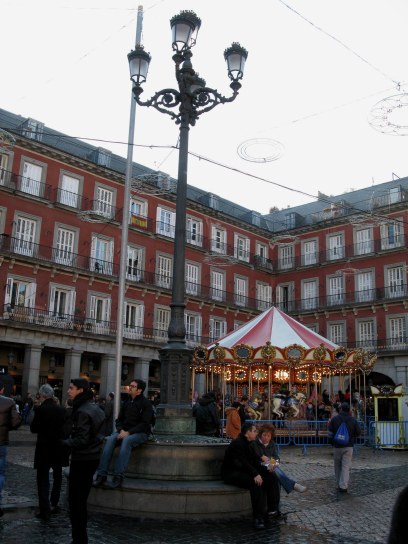
As it was dusk, and this carousel – or as I knew it when growing up to be called a 'merry-go-round' – was graced by only one small passenger who hadn’t been very merry at all.
Seeing the camera, however he soon was happy to be distracted by having his photograph taken.
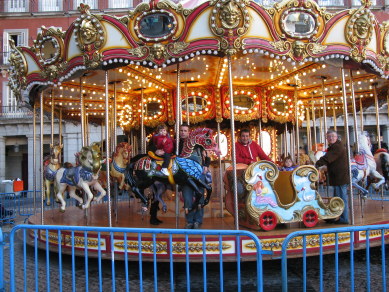
Back amongst the Christmas Market crowds around the wood cabin style stalls, there was a brisk business in silly hats and prankish paraphernalia.
In Spain and other Spanish speaking countries, along with Christmas, on December 28th the Feast of the Massacre of the Innocents or Día de los Santos Inocentes is especially celebrated.
This is the remembrance of the event that according to the account in the Gospel of Matthew saw King Herod ordering the massacre of all boys under the age of two. This is the time that Mary and Joseph fled Bethlehem with their son the baby Jesus.
However, this New Testament version is unique to Matthew’s Gospel and historians question its truth. The brutality of Herod has been well documented by many sources who record his murder of his own three sons, his mother-in-law, and his second wife. It is only Matthew who adds to this with the wide scale massacre – which according to historical records of the small population of Bethlehem at the time, had it indeed taken place, would have killed up to twenty infants and not the hundreds of thousands later claimed.
Nevertheless, the 'Massacre of the Innocents' has a play on words from Inocentes meaning “Innocents” to Inocentadas or practical jokes. The day is celebrated by radio stories rather like those we may know from 1st April or April Fools' Day, trying to trick each other into believing silly stories, prankster tricks, wearing silly hats, cutting out paper figures and sticking them on the back of unsuspecting people, and a myriad of other practical jokes and nonsense.
Pranks need props, and many were to be had.
Being a Spanish celebration, making as much noise as possible is essential and musical noise makers were there for the choosing.
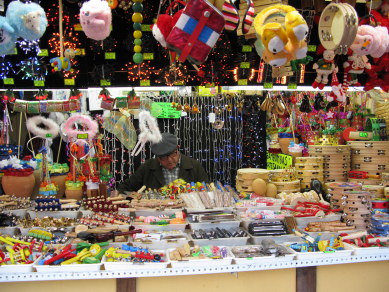
Silly hats abounded.
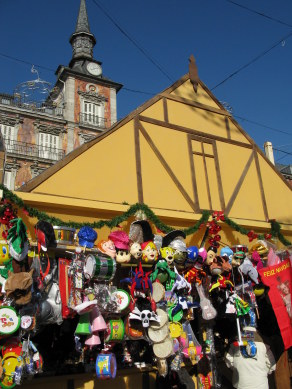
Thinking back to the Mainz Carnival Guards who sport Bonaparte-era French military uniform look-alikes recalling French occupation of the Rhineland – and even the carnival flag being the French Tricoleur flag with a yellow stripe added, I wondered if the tradition of silly hats hearkened back to something similar here: poking fun at controlling forces of a Spanish type.
In my research later, I didn’t find any reference to there being a relationship, but to me it seemed possible there was one to the wearers of “funny hats” who in past centuries have been feared throughout all of Spain, especially during the Franco era.
The three cornered hat of the Guardia Civil – the national police force, is such a “funny hat”. The Guardia Civil has a chequered tradition with a past history of violence. In Spain it was a popular joke that the three cornered hat of the Guardia – el Tricornio - was magical because it gave ultimate power to those who wear it.
However, these hats really were “innocent” though, so perhaps my imagination is falsely based.
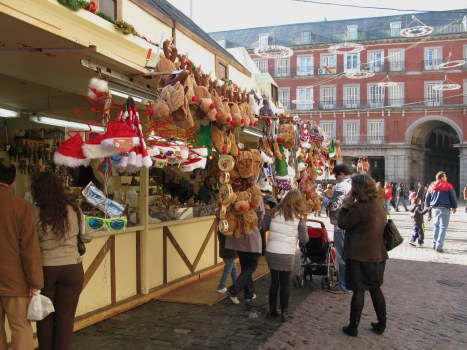
In the Madrid Christmas Market the range of silly hats goes beyond that of the Santa hats, headband reindeer horns, or angel halos of other countries: for one thing the whole animal kingdom seemed represented.
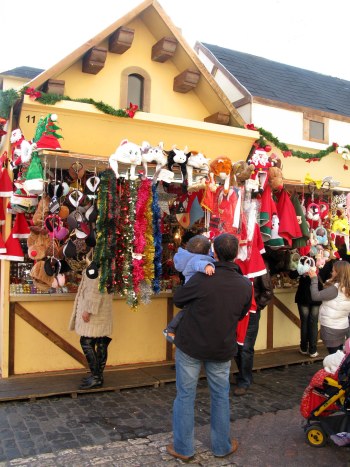
Helium balloons were anchored from floating away in colourful clouds of metallic colour.
Here were the monster, the giants, the unicorn and the wild boar killed in Grimm’s fairy tale by the brave little tailor who actually only killed seven flies – but went on to marry the beautiful princess after rather embellishing what he meant by the statement that he “killed seven”.
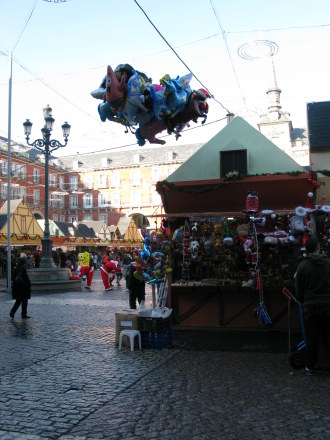
The whole square was strung with a group of floating circles of light.
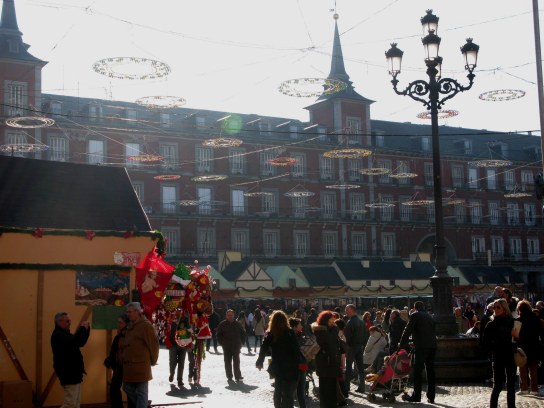
The Plaza Mayor is one of the places people go to see Madrid’s best Christmas lights. Although I was there late in the afternoon and not at night, I could imagine the light circles seeming to float in the dark Christmas sky.
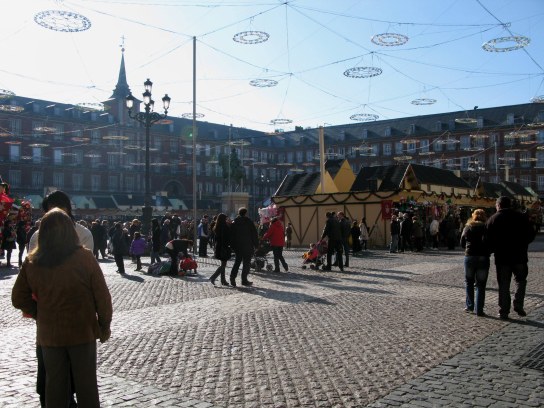
Looking up at them against the intensely blue sky of a Madrid December dusk I suddenly saw something iridescent and floating: It was a giant soap bubble.
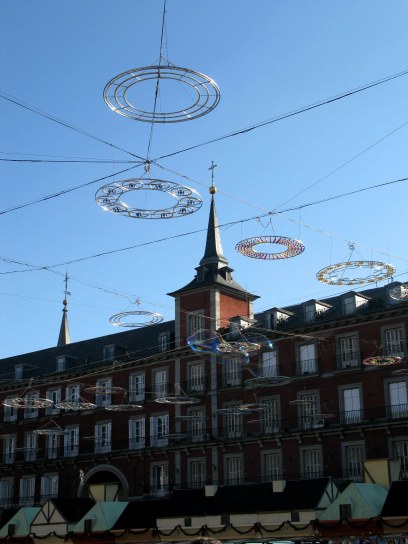
Like the children, I was immediately drawn to the source.
What I found was a magician with a real talent for creating the biggest soap bubbles
one could imagine.
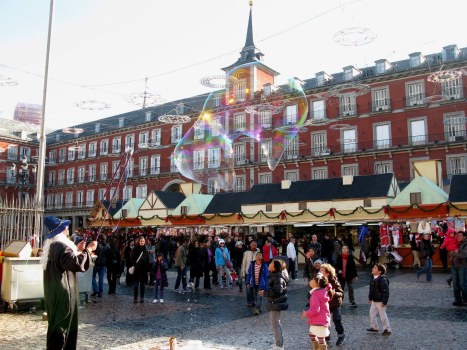
We were all totally captivated and when the magician paused, he was urged on by eager young voices begging for more.
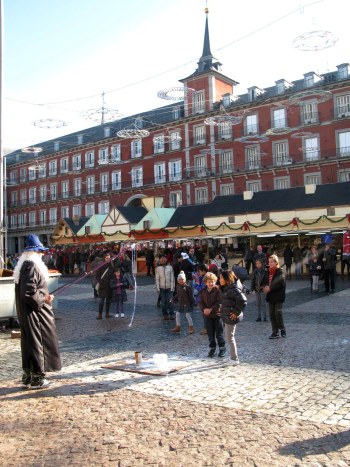
The resulting bubble was not a disappointment, and the children danced with glee.
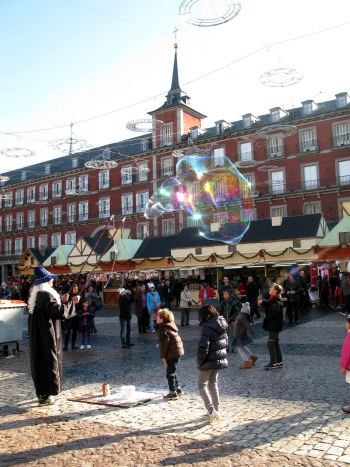
This was definitely a different yet the same Christmas Market.
The magician reminded me of a quote about magic and its relationship to love.
Love and magic have a great deal in common.
They enrich the soul,
delight the heart,
and they both take practice.
Here in the heart of Madrid was a perfect place to see both at work.
What a setting for a Madrid Christmas Market!
The Plaza Mayor is magnificent at any time of year.
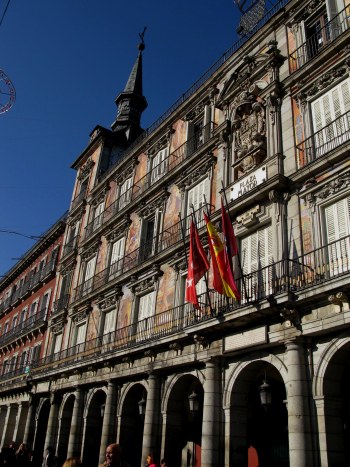
Built in the early 1600s, the Plaza Mayor was originally called Plaza del Arrabal, then in honour of the Constitution in 1812, Plaza de la Constitución. This name was reinstated and changed several times. It was changed to Plaza de la República in 1873, and back again in 1876.
When the Bourbon King came to power it was again renamed, this time Plaza Real. Bourbon Kings (in Spanish Borbón) have reigned in Spain over sporadic periods including our current era (1700–1808, 1813–1868, 1875–1931, and since 1975).
At the end of the Spanish Civil War the name Plaza Mayor became a constant, lasting until now.
The three-story series of buildings are actually a series of residences, with 237 balconies overlooking the plaza.
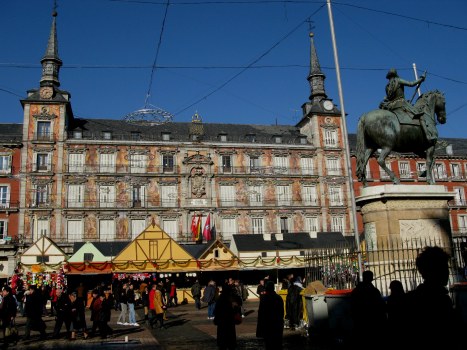
There are nine entrance ways. In one was standing this costumed figure. He was definitely a modern-day pirate: his running shoes gave him away!
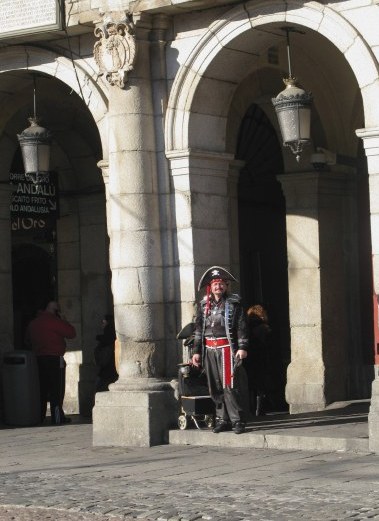
Some of the entrances have magnificent full-planked wood panelled doors.
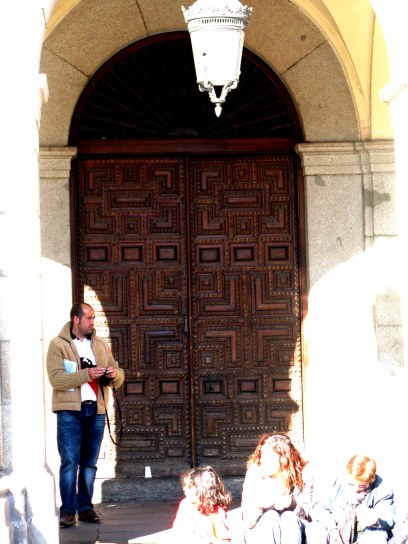
I noticed a troupe of musicians clad in medieval costumes gathered together to agree their play list.
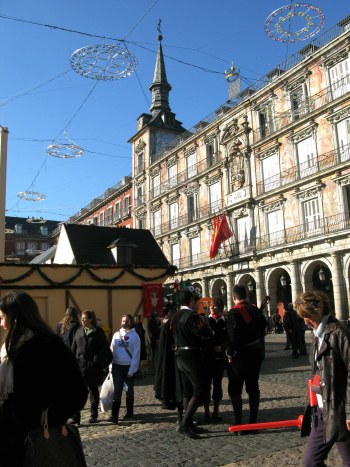
Once agreed, they set out to the tune of one lute player, their cloaks resplendent in badges recording their participations and achievements.
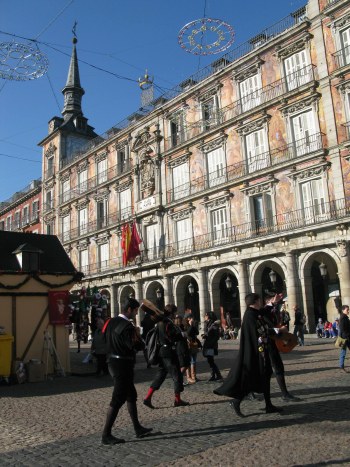
The Madrid Christmas Market was something different from any other I had attended and I was happy to have had such a unique insight into traditions and festive fun previously unknown.

It is a setting and experience I shall always treasure.
It’s always hard to explain how much pleasure you can get from amassing your courage to go somewhere special on your own, but I subscribe to the adage that says:
Live for moments you can’t put into words.
Visiting the Madrid Christmas Market was one of those moments.






